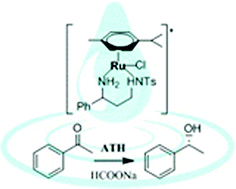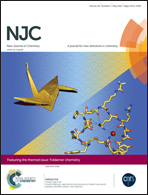Simple 1,3-diamines and their application as ligands in ruthenium(ii) catalysts for asymmetric transfer hydrogenation of aryl ketones†
Abstract
In this research work simple unsymmetrical 1,3-diamines were studied. The synthesis of the diamines started from non-commercial available compounds. S-5a and S,S-5c were obtained by biocatalysis with non conventional yeast, Rhodotorula rubra MIM 147, with excellent 99% e.e. and d.e. up to 90%. Different approaches of synthesis were applied to the same backbone to study both the steric and electronic effects of the ligands. The reactivity of the corresponding ruthenium complexes was evaluated in the asymmetric hydrogen transfer reduction of acetophenone as a standard substrate and of other different aryl ketones, highlighting the flexibility of the six membered chelating ring. A screening of the reaction conditions indicated aqueous media in the presence of HCOONa as a hydrogen donor to be the best system for overcoming the lack of stereocontrol thus allowing us to obtain 56% e.e. in the reduction of acetophenone with the complex in which the ligand was diamine 1, revealed as the best in terms of reactivity and stereoselectivity also in the reduction of the other different aryl ketones, in particular for α-tetralone, i (63% e.e.).


 Please wait while we load your content...
Please wait while we load your content...